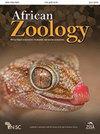Temporal Partitioning of Diurnal Bird and Nocturnal Small Mammal Visitors to a Winter Flowering Endemic Succulent
IF 0.5
4区 生物学
Q4 ZOOLOGY
引用次数: 1
Abstract
Floral nectar is an important attractant and reward for visitors, and is often produced in synchrony with peak activity of pollinators. Aloe peglerae flowers in winter, and previous studies have shown that it is pollinated primarily by diurnal generalist birds, with small mammals making additional contributions to pollination at night. Nectar produced during the day is the main attractant and reward for birds, but the nectar rewards available to small mammals are unknown. This paper investigates nectar availability in Aloe peglerae, because small mammals may be feeding on remaining, or freshly produced, nectar at night. Nectar availability over a 24-hour period was measured in screened and unscreened plants (n = ten plants per treatment), and the associated partitioning of visits by diurnal birds and nocturnal small mammals assessed. Nectar is constantly available over 24-hours, but in different quantities. Nectar volume of screened (nectar availability) and unscreened (standing crop) plants, is significantly higher early in the morning after sunrise, compared with all other sampling periods during the 24-hour period. Nectar concentration did not vary over 24-hours, averaging 11.5 ± 0.4% w/w (unscreened) across the entire 24-hour period. Peaks in visits by different guilds occurred at periods (i.e. diurnal birds and nocturnal small mammals) when nectar availability was high. Aloe peglerae has higher daytime nectar production, when its primary pollinators are most active, but the continual, albeit reduced, nectar availability at night attracts small mammals. Mobile diurnal birds, and less-mobile nocturnal small mammals, both rely on this nectar resource during dry and cold South African winters and, in turn, are important pollinators for this Critically Endangered Aloe species.冬季开花的特有多肉植物中日间鸟类和夜间小型哺乳动物的时间分配
花蜜是一种重要的吸引物和奖励,通常与传粉者的高峰活动同步产生。芦荟在冬季开花,以前的研究表明,它主要由白天的鸟类授粉,小型哺乳动物在夜间也有额外的授粉贡献。白天产生的花蜜是鸟类的主要引诱物和奖励,但小型哺乳动物可获得的花蜜奖励尚不清楚。由于小型哺乳动物可能在夜间以剩余的或新鲜产生的花蜜为食,因此本文研究了芦荟中花蜜的有效性。在筛选和未筛选的植物中测量了24小时内的花蜜供应(每次处理n = 10株),并评估了白天鸟类和夜间小型哺乳动物访问的相关分配。花蜜在24小时内持续供应,但数量不同。与24小时内的所有其他采样时段相比,筛选过的(可用花蜜)和未筛选过的(直立作物)植物的花蜜量在日出后的清晨明显更高。花蜜浓度在24小时内没有变化,在整个24小时内平均为11.5±0.4% w/w(未筛选)。不同行会的访问高峰发生在花蜜可得性高的时期(即白天活动的鸟类和夜间活动的小型哺乳动物)。芦荟在白天有较高的花蜜产量,这是它的主要传粉者最活跃的时候,但在夜间持续的(尽管减少的)花蜜供应吸引了小型哺乳动物。白天活动的鸟类和夜间活动较少的小型哺乳动物在南非干燥寒冷的冬季都依赖于这种花蜜资源,反过来,它们是这种极度濒危的芦荟物种的重要传粉者。
本文章由计算机程序翻译,如有差异,请以英文原文为准。
求助全文
约1分钟内获得全文
求助全文
来源期刊

African Zoology
生物-动物学
CiteScore
2.60
自引率
9.10%
发文量
18
审稿时长
>12 weeks
期刊介绍:
African Zoology , a peer-reviewed research journal, publishes original scientific contributions and critical reviews that focus principally on African fauna in terrestrial, freshwater, and marine ecosystems. Research from other regions that advances practical and theoretical aspects of zoology will be considered. Rigorous question-driven research in all aspects of zoology will take precedence over descriptive research. The Journal publishes full-length papers, critical reviews, short communications, letters to the editors as well as book reviews. Contributions based on purely observational, descriptive or anecdotal data will not be considered.
The Journal is produced by NISC in association with the Zoological Society of South Africa (ZSSA). Acceptance of papers is the responsibility of the Editors-in-Chief in consultation with the Editors and members of the Editorial Advisory Board. All views expressed are those of the author and not necessarily those of the Editors or the Department.
 求助内容:
求助内容: 应助结果提醒方式:
应助结果提醒方式:


